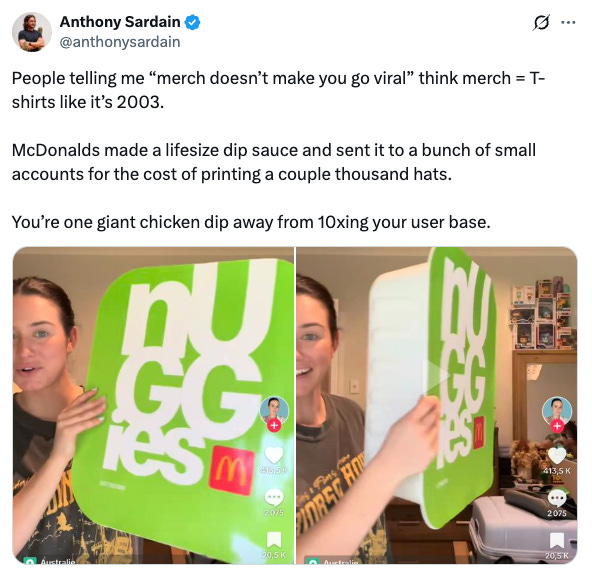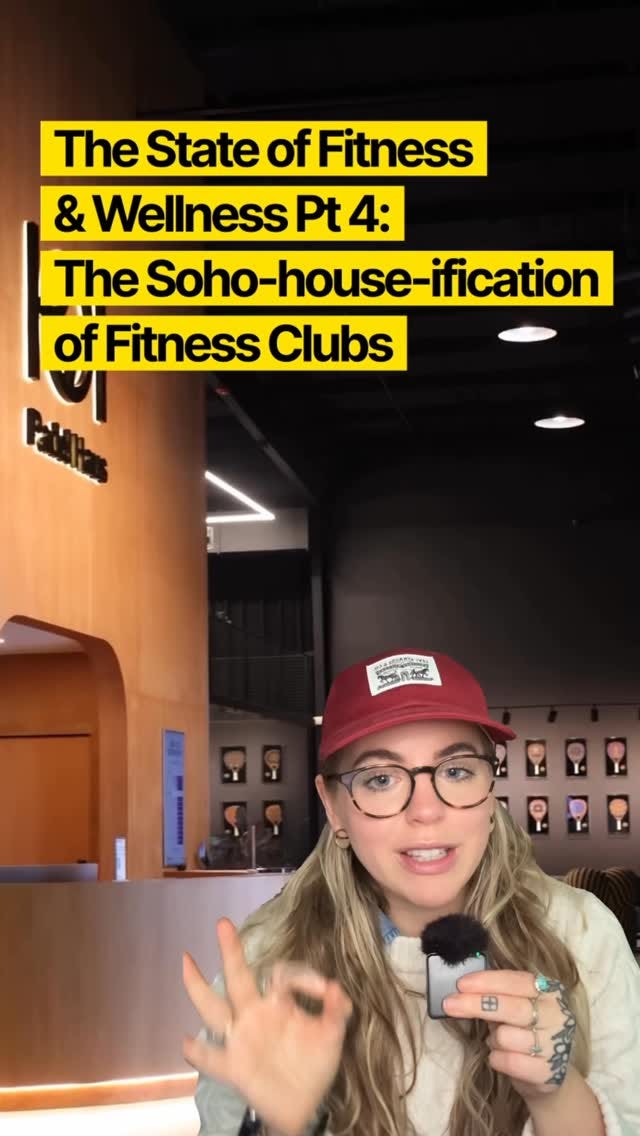Internet economies and alternative spaces
You're telling me the media earned this value?
Welcome to this week’s HYPER. We’re tackling courses that should exist, how to whitelist content, what EMV is, how you measure seeding, and Clayton dives into what’s right and wrong with alternative spaces.
To start… so many people are learning and solving issues with infoproducts. Next to social media overall its one of the biggest changes to consumer learning over the last decade that your business or personal problems can be solved in a weekly email or small group cohort. Learning the process for Cut30 I’ve been in the weeds watching how people do these and what to do better, and just how impactful they are.
BUT… a lot of creators basically just offer different versions of the same course for their info products. This is a shame because there are pretty huge market gaps out there you could make a lot of money with an actually drive value. A few of these are below, and I break down with checklists in this video. Please, someone, make these.
Trending audio community that curates the best audios on IG and TikTok each week, and adds brand safe commercial sounds that don’t suck, plus selects from MusicBed and similar platforms (especially close matches to trending). Social media managers need this and will pay for it.
Lighting for home setups and studios - training program, gear list by space size, and 1:1 or small group calls to workshop dialing in setups. This would do really well.
Meta Ads in 7 days. Daily group calls for 7 days taking people 0-1 on setup, campaigns, ad sets, access, troubleshooting, catalog ads etc. Known time-frame, deal with everyones problems and once, and then easy upsell to something bigger
Housekeeping
We’ve been working on Hyper for 2 years now.
And we’d love to know what you think about it. It’s been a busy year, but we like to periodically take stock of where we stand and improve what we’re creating for you.
We've created a quick Typeform survey that takes just 2 minutes to complete, and we’d love it if you could take a moment to fill it out so we can continue creating content you’re interested in.
A guide on how to whitelist content
We got a super positive response from the influencer guide we sent out from AGM a few weeks ago, so we’re back with more, this time taking a deep dive into the topic you asked the most about: whitelisting
What is whitelisting?
It’s when a brand runs paid ads through a creator’s account, rather than its own. So instead of seeing a video from “BRAND X” in your feed, the ad shows up as if it’s coming from a creator you follow (or one you’ve seen recently), but it’s extended, boosted, and targeted to more people.
If you’ve seen an ungodly amount of Oren showing up in ads from Anthropic, Death to Stock, or Foreplay… that’s whitelisting at work with him as the creator.
Why does this matter?
Because trust travels. Creators already have the audience, the voice, the credibility and they most often stop the scroll better than a brand. The higher the hook rate on an ad, the more spend it gets, which has more potential for scale and success.
So, when you whitelist, you’re not just borrowing a creator’s content, you’re borrowing their relationship with their audience. And that is infinitely more effective than a brand shouting from its own account with zero context.
Brands often even test this with employees and founders, just because human accounts perform better.
A free guide on whitelisting
To help more brands optimize this for themselves, our friend Josh and his team at Aligned Growth Management have put together a thorough, free guide on exactly how to kickstart your whitelisting program, covering all of the points below.
What is whitelisting and why you should test it
The 3 methods of whitelisting (and how to execute with each one)
How to make whitelisting a scalable, incremental channel
How to find creators and influencers for whitelisting
How to contract influencer partners for whitelisting
AGM is a fantastic influencer management agency that’s worked with brands like Ghost Energy, Hexclad, FabFitFun, Owyn, Heart & Soil, and more.
This segment is in partnership with Aligned Growth Management.
The 7 stages of brand-building
In Oren’s latest Youtube, he dives into the 7 stages of building a brand, and what to concentrate on in each stage. For founders with whiplash at all the things you’re being told to concentrate on, or marketing team members trying to figure out if your company is focused on the right things, this is a video from someone who has seen the good, the bad and the ugly of each stage.
What the heck is EMV
I put out a video earlier this week about EMV (earned media value) is the dollar amount a brand would have had to spend on paid ads to get the same exposure an influencer or creator delivered organically. It’s not a perfect metric by any means, but as product seeding becomes more prevalent, EMV has become one of the most important numbers in modern brand building.
Brands use it to compare campaigns, track ROI of influencer partnerships, and measure online attention.
The playbook is simple:
A customer, fan, or influencer posts about your brand without being paid → that’s earned media.
Brands solicit this by sending product mailers out to targeting influencers and creators in the hope they post (mostly unpaid)
The better the product (and the more intentional the mailer or experience), the higher your posting rate.
The higher the posting rate, the better your engagement and content flywheel
EMV retention is a useful metric on top of this, how many people who post about a brand, then post about it again.
As you’ve heard me mention before, in my role as Creative Director at &vest, we work with a portfolio of beauty brands on their brand strategy, and every is urgently obsessed with EMV. How to scale it for our companies, the right influencer lists, mailers, the transition from organic posting to paid influence, using whitelisting like above, and most importantly its impact on more important company metrics (like revenue). We’ve found something telling from our internal data: in North America, there’s an 80%+ correlation between EMV growth and retail sales growth for brands in mass distribution. Attention translates to sales, and this happens from organization operations and creative campaigns operating in tandem, often.
Some of the best examples lately:
Biores bubble mailer is completely out of hand (and great for content)
Morphe created a mailer positioning their products as alternatives to cosmetic procedures—this helped them jump from #34 to #23 in cosmetics EMV rankings, and improve retention (#71 to #6).
Rhode sending out an egg you drop in water.
And shout out to the OG McDonalds massive dipping sauce
Death to the middle class and our need for alternative spaces
Perhaps one of the more controversial announcements this year was KITH’s decision to launch its own private members club.
Membership costs a one-time fee of $36,000 and an additional $7,000 each year to maintain.
Reminds us of a video that our friend (and noted Cut30 grad) Tatum Brandt made on the “SohoHouse-ification” of fitness clubs.
You should watch it; it’s great.
So yeah, it’s obviously ridiculous to charge that for an entry fee.
But it’s also not surprising.
And it’s part of a broader wave we’ve been tracking, which is the rise of wellness and lifestyle clubs that feel more like Soho House than a gym or café.
You see it with Equinox rolling out six-figure memberships.
Erewhon turning smoothies into a $20 status symbol.
Even with boutique fitness and recovery spaces or spas that have been rebranded as “performance labs.”
But the real shift isn’t about the price. It’s about what brands are positioning themselves to be.
For years, the product was the point: sneakers, smoothies, treadmills. Now the product is “belonging.”
These brands are no longer satisfied just selling goods or services… they’re building worlds you have to buy your way into.
That’s what makes KITH’s move worth paying attention to. It signals how aggressively brands are pushing to become cultural hubs, not just retailers.
It was probably always the plan to get into hospitality. They want to be the place where you hang out, where you network, where your identity gets affirmed.
The playbook is clear: create scarcity, wrap it in luxury, and sell access as the ultimate upgrade. For the consumer, it’s less about what you buy and more about who you’re buying it with.
For the brand, it’s a way to stretch beyond product margins into something stickier—community as a business model.
This isn’t going away.
Expect to see mid-tier versions emerge everywhere: digital clubs, smaller membership tiers, and hybrid spaces that blend retail with fitness or wellness with work.
KITH’s $36K price tag makes the headlines, but the real story is that more brands are trying to out-community each other.
And the highest form of luxury right now is being able to say: I belong.
Hyper Reports
Check out our market reports. We spend many hours researching markets, categories, and brands & products within the consumer space so you don’t have to.








